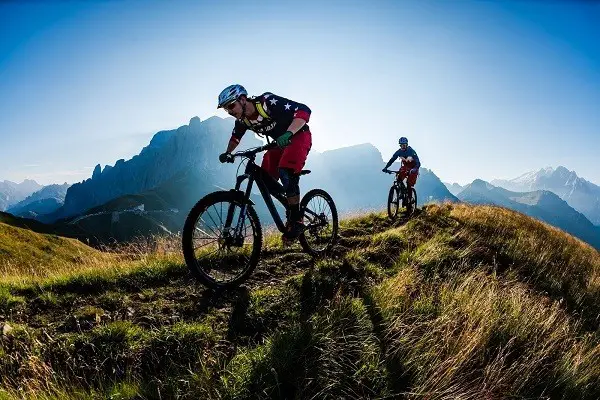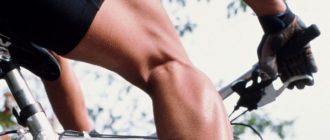Descending a mountain can be a thrilling adventure and the basis for a cool video for your personal blog. But behind the spectacular jumps and virtuoso turns is the serious work of a rider who has repeatedly practiced the same moves, studied the theory diligently, and is clearly aware of what happens to his bike during the descent. In any case, downhill biking is quite dangerous and unpredictable activity, which should be approached as prepared and armed. And you should start with the theoretical basics.
Instructions on how to go downhill on a bicycle
To go down the mountain on a bicycle and remain unharmed, getting a dose of adrenaline – it is reality. Moreover, there is a separate category of cyclists who do not recognize a quiet ride. Their roads are steep slopes, riddled with tree roots, potholes and bumps. Fans of downhill or trail riding don’t accept smooth asphalt. For them it’s just a way to get to the relief terrain. And there, on the mountains and slopes they can get a dose of adrenaline and vivid emotions.
There are a lot of fans of extreme types of cycling. Guys not just ride the mountains, risking their health – athletes and enthusiastic amateurs practice for a long time, hone their skills and learn, above all, the theoretical basis of the speed of descents from the mountain.
To make a downhill run not just exciting, but also safe, is a must:
- Remain calm under all circumstances.
- Be prepared for downhill jumps and overcoming obstacles.
- Evaluate the road in front of you as carefully as possible.
- Brake correctly on downhill.
- Control your speed and maintain your balance.
- Adopt a comfortable riding position depending on the situation on the road.
- Wear a helmet, knee pads, elbow pads, and other protective equipment.
- Make sure your bicycle is in good condition.
Going down a steep slope on a rough road, you need to practice extreme braking skills, as well as learning to take the best position on the bike. Let’s take a look at the basics.
Getting into the right position
During normal cycling on a level road, absolutely all muscles work. The cyclist keeps his balance by turning the pedals in parallel and assessing the situation on the road. During a steep descent down a mountain, the muscles start working harder. Here it is important to hold the steering wheel confidently, but not to cling to it with a dead grip. At the same time, you should keep your back muscles as relaxed as possible. The correct landing of the rider includes 3 basic moments:
- Proper distribution of the center of gravity.
- A confident position of the hands and the body of the cyclist.
- Position of the limbs on the pedals.
Going down a steep hill, you need to consider that the center of gravity will tend forward. Therefore, the pelvis of the rider should be on the rear edge of the saddle, tending to the rear wheel. If the front wheel on the descent began to drive from side to side, you should move forward slightly.
The rider’s body leans slightly forward, while keeping the arms bent and resting quietly on the handlebars. On a straight descent, keep your feet parallel to the ground on the pedals so that you do not accidentally hit any protruding obstacles with your feet.
Your legs should not be clamped and kept in tension. The joints will then act as shock absorbers on the downhill for possible jumps and collisions with obstacles.
Brake function
The functionality of the braking system should be checked before each trip. Especially when it comes to extreme types of riding. There is an opinion that it is not worth engaging the front brake when going down the mountain quickly, as there is a chance of falling off the bike. In fact, it is necessary to engage both rear and front brakes while descending.
During the descent from the mountain, the bulk of the cyclist’s weight falls just on the front wheel. If only the rear wheel is blocked, it is not possible to stop the bike completely because its surface is not in contact with the ground. Therefore, for braking in this case it is advisable to use the front brake. The rear brake is needed more for correction of movement.
To stop on time on a slope, adhere to the following plan of action:
- Try to shift the center of gravity back as much as possible;
- apply the rear brake and gently apply the front brake;
- Having reached optimum speed, shift the center of gravity in the opposite direction and continue driving.
All these manipulations should be brought to automaticity. Therefore, it is worthwhile to train in advance on the gentler slopes or even flat roads, to learn how to brake on a bicycle.
When braking, you should listen to the “melody” of the rear and front wheels. If you hear a distinct hiss – the wheels are blocked, that is, they do not rotate, but simply shift on the ground. In this case, you should loosen the brake a little.
Turns on the downhill from the mountain
Going down a flat mountain is not difficult if you learn to keep your balance well. It’s much harder to steer your bike around corners. Here’s how to do it:
- In a turn, tilt your body inward on the axis;
- keep your inner foot on the pedal in the up position so you don’t touch the ground;
- try to keep your eyes straight on the road, but keep your sideways vision alert for potential obstacles.
The most important thing for the cyclist is not to concentrate on the nearest meters, but to look at the road in perspective, calculating any situations. If there is any obstacle on the way (a stone or a bump, for example), you should turn your head along the trajectory, and not consider the potential threat. In this case, all movements of the rider will be confident and the descent from the mountain – safe.
Three types of difficult slope
As we said, there are straight slopes, and there are bumpy and with turns. There are a total of three types of slopes depending on their difficulty. Let’s look at each one in more detail.
Descent on a mountain mountain mountain bike with a slight slope
Bend your elbows and knees, but do not strain them. Move your center of gravity slightly to the rear wheel and focus your eyes on the nearest 3-5 meters in front of you. Apply the front and rear brakes while braking.
Going down a steep hill on a bike
Again, bend your elbows and knees, but do not pinch your limbs. Lower the pelvis almost to the rear wheel. Eyes should be directed exclusively forward, but further than 5 meters, in time to notice a suddenly appeared on the road tree. Try to move at the lowest speed possible to keep the balance. Both brakes should be engaged. If the wheel starts to slip, release the brake a little and keep going.
Downhill at high speed
The center of gravity should be shifted to the carriage. Arms bent at the elbows and legs bent at the knees. Your limbs should be firmly in place, but remain relaxed. The eyes focus on the nearest 4-6 meters in front of you. If possible, you should cover a slightly larger area with your eyes, again in order to notice an obstacle suddenly appearing on the road. Driving down the mountain at high speed, you need to brake smoothly, but clearly.
Recommendations
Beginning extreme riders should first learn the theory of descending a steep mountain, then practice their skills on a flat surface or hills with a gentle descent. Keep in mind that on your way there may be a variety of obstacles, not necessarily a rock or bump – it may be a hole or a fallen tree. If time does not notice such an obstacle, you can not only damage the bike, but yourself a couple of weeks to be packed in the cast. By the way, always carry a repair kit for your bike to be able to patch the tire in case of a puncture. Or, as a more advanced option, put anti puncture tires on your bike.
Experienced riders make the following recommendations:
- Try not to ride alone, but in the company of like-minded riders. In the event of a bad fall, the help of another person may come in handy.
- Routes should be laid out in advance. Again, so that in the case of an unpleasant fall your partner can help get out to the nearest flat road.
- Keep in mind that in the mountains is not always possible to use a cell phone.
- Always carry a first-aid kit with the necessary tools and medicines.
- Under no circumstances go to the mountains without a helmet and special equipment for the cyclist.
And another rule that should be considered – soberly assess your capabilities. If you are not confident in your abilities, it is better to overcome a steep descent, dismounting from the bike. If your skills leave much to be desired, practice on a quieter track. The optimal length of a gentle descent – 10 meters. At the end should be sure to have a flat area for effective and safe braking.
Conclusion
Downhill and other types of extreme cycling are activities for trained cyclists. Riders train a lot before showing a spectacular descent from a steep slope. Yes, the spectacle is thrilling, but you should assess your capabilities sensibly. In any case, having a reliable bike for downhill and knowing the theory, you can practice on quieter slopes, and then conquer the mountains.










